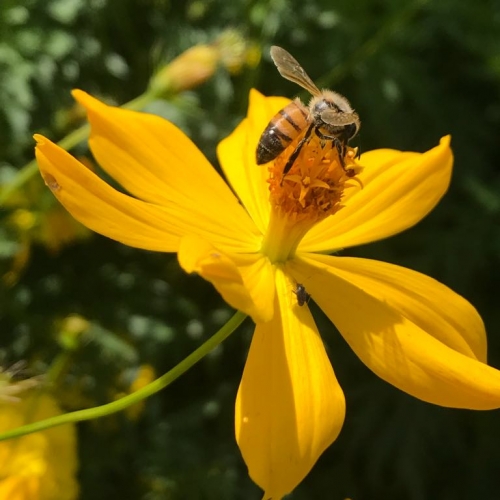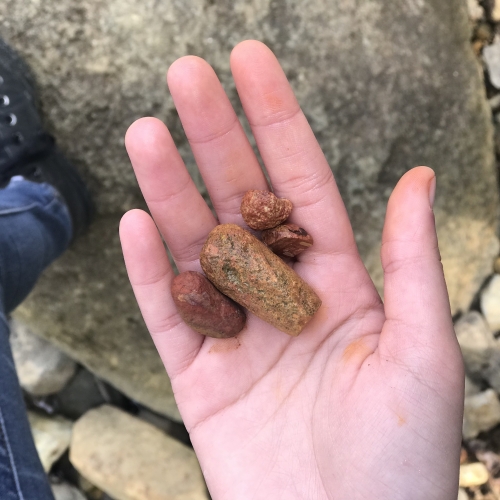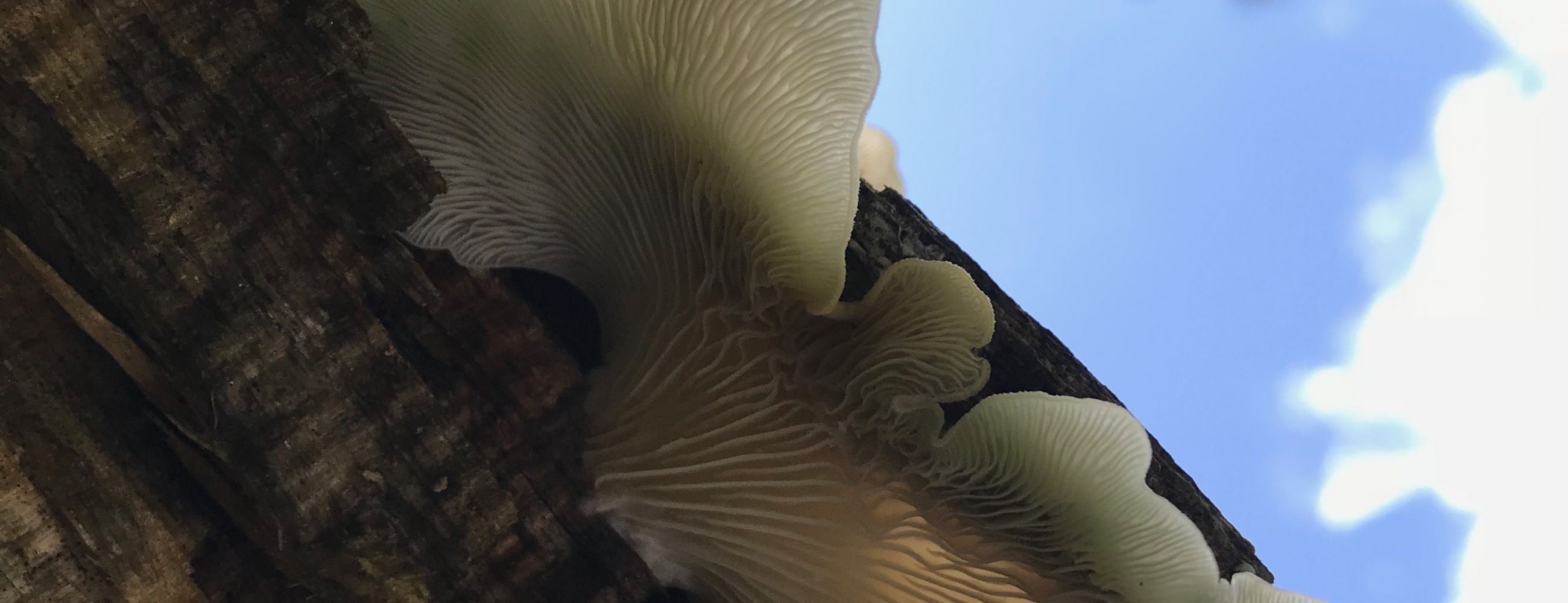
Tools for Landscape Conservation
Even though nature is resilient and can adapt to constant change, it is crucial to support efforts for the conservation of the Puerto Rican landscape, especially now that we face great challenges because of climate change.
Here we share a series of references, tools, ideas, and contacts for you to learn more about conservation initiatives in Puerto Rico.


Feelings Vocab
How do we feel? This Feelings Vocab helps us to recognize emotions while we reflect on the actions that we perform in the forest.

Peace
Peaceful
Serene
Relaxed
Quiet
Tolerant
Trusting
Harmonious
Happy
Cheerful
Glad
Proud
Fascinated
Optimist
Communicative
Friendly
Loving
Cordial
Humbled
Compassionate
Valued
Recognized
Curious
Amazed
Surprised
Excited
Engaged
Safe
Fun
Active
Cheerful
Strong
Energized
Effusive
Open to dialogue
Sociable
Receptive
Independent
Generous
Available
Helpful
Bothered
Angry
Frustrated
Indignant
Grumpy
Violent
Furious
Sorry
Worried
Lonely
Disinterested
Indifferent
Pessimistic
Dispirited
Confused
Amazed
Perplexed
Scared
Disconcerted
Blocked
Hurt
Offended
Fragile
Anxious
Sensitive
Vulnerable
Affected
Isolated
Dissatisfied
Indifferent
Cold
Resented
Indignant
Resentful
Grumpy
Fearful
Horrified
Insecure
Agitated
Tense
Closed up
Nervous
Passive
Suspicious
Undecided
Restless
Annoyed
Disoriented
Pensive
Sorry
Timid
Inhibited
Shy
Frightened
Overwhelmed
Embarrassed

Glossary
Algae: A group of diverse aquatic organisms that perform photosynthesis and contain chlorophyll.
Archipelago: A group of islands.
Biodegradable: A substance that can be quickly disintegrated by living organisms.
Canopy: The forest or arboreal canopy is the habitat that exists in the superior layers of the forest, where we find treetops, lianas, epiphytes, birds, and other animals.
Cimarrones/Runaway slaves People of African descent who freed themselves from slavery through rebellion.
Climate change: Climate change directly or indirectly attributed to human activity that alters the composition of the global atmosphere and adds to the natural variability of the climate observed through comparable time periods.
Coal cellars: Refers to the making of carbon through burning the vegetal matter of the forest, obtained mainly from trees that have been cut down for this purpose.
Composter: Container or space where organic matter transforms into humus through a process of decomposition.
Conservation: Activities done with the purpose of ensuring the permanence of ecosystems.
Dams: Stone or cement barriers built for storing and/or regulating the course of the water in rivers and creeks.
Deforestation: Process through which the forest cover is reduced and/or disappeared.
Demarcating: To mark the limits of an area of land. It differs from fencing, in that the marking is done with cement posts that indicate a division.
Ecosystem: A community of living beings and their physical surroundings.
Emerging: That emerges, surges, or appears with force.
Endemic: In Biology, it refers to a species that is exclusive to a determined area.
Fertilizer: A substance used to fertilize the soil.
Forest reserve: A natural area designated for the protection, conservation, and research of its flora and fauna because of its multiple characteristics of special interest.
Forestry: Disciplines that study forests.
Fungus: An organism that belongs to the Fungi Kingdom. The mushrooms we see in the forest and the yeast that we use to cook are part of this great family.
Hatched/opened: That sprouted or were born.
Homogenous: Of uniform composition and structure. In this case, when talking about the homogenization of nature, we mean the loss of diversity through the reduction of the amount of species that exist in a determined area.
Landscape: A natural and ecological system that consists of a mosaic of modified and/or natural ecosystems that show a peculiar configuration because of its topography, vegetation, land use, and infrastructure.
Latifundium: A farm of great size that belongs to only one owner.
Lichens: An organism that results from the symbiotic association of an algae and a fungus. They live on rocks, soil, walls, tree barks, and even leaves.
Micologist: A person dedicated to the study of fungi.
Microorganisms: Organisms of microscopic size.
Monoculture: An agricultural system that plants and grows only one vegetal species on all the available land.
Mutualism: A biological interaction between different species that results in mutual benefit.
Nursery: A facility designed to germinate and assist during the first stages of development of all kinds of plants and trees.
Organic matter: Matter derived from a living organism.
Organic waste: Leftovers from organic matter, like the skin of fruits, fallen leaves, and cut grass.
Parceleros/Smallholders: People who live in a parcel which, in turn, is a small piece of land.
Petroglyphs: Rock engravings made by wearing down the surface of the rocks.
Pinnations: A botanical term used to describe leaves that have numerous folioles placed on either side of a main axis.
Predator: An animal that hunts other animals to feed itself.
Rainforest : A humid forest.
Raw materials: Materials extracted from different natural sources (animals, minerals, plants, fossils) which are later processed to elaborate goods. For example, the raw material for much of our clothing comes from cotton plants.
Resilient: The ability of a determined system to recover and find a balance.
Sustainable: The use of environmental systems in a way that satisfies our current needs for natural resources without, in turn, compromising their own needs, for the wellbeing of future generations.
Totem: Animated being or object that serves as a cultural symbol and emblem for a determined social group.
Trail: Path made for the transiting of animals and/or people.
Vermicomposter: A space to decompose organic matter with worms.


Conservation Practices
Here we share ideas to continue developing a good relationship with our environmental and social surroundings.
• Enjoy your ecosystem. Make of your garden a friendly space for wildlife. You can plant bushes, trees, and flowers for more and more species to visit you.
• Locate a recycling center in your community or near your community.
Do you want to be responsible with your trash? Remember that human beings are the only species that creates non-biodegradable material, thus provoking the contamination of our ecosystems.
Anímate, separa tu basura. Cada cosa tiene su lugar: materia orgánica, plástico, papel/cartón, cristal y aluminio.
For more information on how to recycle, you can visit this website.
• Create a composter or vermicomposter for organic matter. It is a very special and fun way to transform organic waste into Besides, you can give this wonderful fertilizer to your plants.
• Research. Ask people from your community, family members, community leaders, farmers, healers, and/or artisans about the history of the landscape where you live.
• Celebrate diversity, be it biological or social. On top of supporting and respecting environmental biodiversity, let’s also do it with the infinite expressions of social and cultural diversity around us.


Connect
We want to support your enthusiasm for nature and remind you that you are not alone. Here is a list of environmental organizations for you to:
• Be able to participate in environmental projects or programs focused on the reforestation and conservation of the Puerto Rican landscape.
• Continue to expand your physical, intellectual, and emotional relationship with the forest.
• Grow your relationship with the diverse ecosystems that characterize Puerto Rico.
• Deepen your ecological practice while you have fun.
Organizations
Amigos y Vecinos de El Yunque
Comunidad La Vega, Rio Grande
Barcelona, Comunidad del Bosque
Rio Grande
Coalición Pro-Corredor Ecológico del Noreste
Luquillo and Fajardo
http://www.corredorecologicodelnoreste.org/
Producir
Canovanas
Sierra Club
Sierra Club Puerto Rico
https://puertorico.sierraclub.org/
Fundación Amigos del Yunque
El Yunque
http://www.amigosdelyunque.org/
Eastern National
El Yunque
CEDEPEC
Ceiba
http://www.cedepec.com/home.html
Para La Naturaleza
Fajardo
Small educational, environmental, and agricultural grassroots businesses
Foodscapes Caribe
Luquillo
http://www.foodscapescaribe.com/
Hydro Ceiba
Ceiba
@hydroceiba


References
For the creation of this website, we consulted books and online references. We include them here for everyone’s benefit.
Textbooks
Alexis Massol González, Edgardo González, Arturo Massol Deyá, Tinti Deyá Díaz, Tighe Geoghegan. 2006. Bosque del Pueblo, Puerto Rico: Cómo la lucha antiminera cambió la política forestal desde la base comunitaria. Políticas exitosas para los bosques y la gente no. 12. International Institute for Environment and Development, London.
Carlos M. Domínguez Cristóbal. 2011. Manual Interdisciplinario de Investigación Forestal. Río Piedras: U.S. Forest Service Department.
Carlos M. Domínguez Cristóbal. 2000. Panorama histórico forestal de Puerto Rico. University of Puerto Rico Press, San Juan.
International Institute of Tropical Forestry. Luquillo Experimental Forest: Research History and Opportunities. U.S. Department of Agriculture, Forest Service. 2012.
International Institute of Tropical Forestry. Passing The Baton From The Taínos To Tomorrow: Forest Conservation in Puerto Rico. U.S. Department of Agriculture, Forest Service. 2014.
Manuel Valdés Pizzini, Michael González Cruz, José Eduardo Martínez Reyes. 2011. La transformación del paisaje puertorriqueño y la disciplina del Cuerpo Civil de Conservación, 1933-1942. Río Piedras, Center for Social Research, University of Puerto Rico.
Maya Quiñones, Isabel K. Parés, William A. Gould, Grizelle González, Kathleen McGinley, Pedro Ríos. 2018. Atlas del Bosque Nacional El Yunque y el Bosque Experimental de Luquillo. International Institute of Tropical Forestry, Puerto Rico.
Websites
Basura Cero. http://www.basuraceropr.org/donde-reciclo.html.
Centro de Periodismo Investigativo – Transparency Network. 2018. http://www.periodismoinvestigativo.com/
Feng Y, Negron-Juarez RI, Patricola CM, Collins WD, Uriarte M, Hall JS, Clinton N, Chambers JQ. 2018. Rapid remote sensing assessment of impacts from Hurricane Maria on forests of Puerto Rico. PeerJ Preprints 6:e265971 https://doi.org/10.7287/peerj.preprints.26597v1
Virtual Flora of El Verde. 2013. http://floraelverde.catec.upr.edu
“GeoAmbiente – Patrimonio Natural (1/3).” Youtube, uploaded by SistemaTV,
October 30 of 2012, https://www.youtube.com/watch?v=WDK7lhLcv6g.
“GeoAmbiente – Patrimonio Natural (2/3).” Youtube, uploaded by SistemaTV, October 30 of 2012, https://www.youtube.com/watch?v=XHvtB8GTINo&t=19s.
“GeoAmbiente – Patrimonio Natural (3/3).” Youtube, uploaded by SistemaTV, October 25 of 2012, https://www.youtube.com/watch?v=jKjRnxWeGIk&t=50s.
Gerardo E. Alvarado Colón. “Ya está protegido el 16.1% de los terrenos en la Isla.” El Nuevo Día, January 8 of 2018. https://www.elnuevodia.com/noticias/locales/nota/yaestaprotegidoel161delosterrenosenlaisla-2279062/
Jorge J. Muñiz Orti Agencia EFE. 2015. “Buscan implicar a comunidades locales en manejo de bosque tropical del Yunque.” PrimeraHora. http://www.primerahora.com/noticias/puerto-rico/nota/buscanimplicaracomunidadeslocalesenmanejodebosquetropicaldelyunque-1093614/
Sharing Nature Worldwide. 2016. http://www.sharingnature.com
Rainforest Conservation Fund. 2018. – http://www.rainforestconservation.org

Acknowledgements
We thank all the collaborators, groups, and organizations who made possible the elaboration of this project. Thanks to Colibrí Sanfiorenzo-Barnhard and Edgardo González González of the Center for Landscape Conservation. To Víctor Cuevas, Raymond Feliciano, Tamara Heartsill Scalley, José ‘Pepe’ Ortega of the Forest Service. To Noelia Báez, María Benedetti, Alexis Dragoni, Héctor Dones, Pedro Dones, Sally Ortíz, Manuel Valdés Pizzini. To the members of the Rosa-Torres family of Barrio Sabana. To the library team at the International Institute of Tropical Forestry. To the staff at the General Archives and the National Library of Puerto Rico. To all the people, groups, and organizations who let us use their visuals for this site. To the members of the Comedores Sociales soup kitchen project, for feeding us during our visits to El Yunque. Many thanks to the young people and the guides who participated in the field trips to put into practice the actions in this site.









